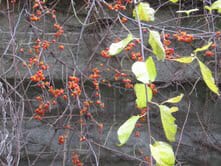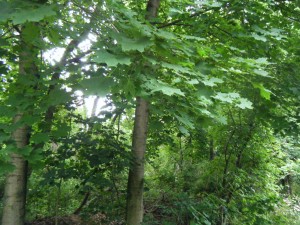by Judy Eisenberg
Native plants are plants that were already growing in North America before European colonies settled here. Many of these native woody plants such as Sugar Maples, Gray Birch, Serviceberry, and native herbaceous plants such as Lowbush Blueberry, Columbine (Aquilegia canadensis), New England Aster, Solomon’s Seal, Foam Flower, Maidenhair Fern and Bearberry still grow today in New England. They have adapted to our climate’s heat, drought, excessive rain, cold, and snow and require minimal labor, fertilizers, herbicides, fungicides and insecticides. Native plants have an interactive relationship with indigenous animals, birds, reptiles, butterflies, insects and many other organisms, and provide them with food and habitat. For further information on native plants, log onto New England Wild Flower Society (www.newfs.org)
Some of New England’s woody and herbaceous ‘invasive’ plants were originally brought here from Europe for use as food crops when the  Europeans first settled here. Non–native invasive plants were and still are imported from all over the world for food crops and for aesthetic horticultural reasons. These invasive alien plants do not provide proper nourishment for wildlife. They spread rapidly, develop self-sustaining populations, upset natures balance, and are displacing the native plants and the organisms depending on them. If you look in your own garden, or walk down the street, you may see invasive plants such as Norway Maples, Oriental Bittersweet, European Swallowwort, Japanese Knotweed, and Bishops Goutweed. For further information on invasive plants, log onto Invasive Plant Atlas of New England (http://www.ipane.org)
Europeans first settled here. Non–native invasive plants were and still are imported from all over the world for food crops and for aesthetic horticultural reasons. These invasive alien plants do not provide proper nourishment for wildlife. They spread rapidly, develop self-sustaining populations, upset natures balance, and are displacing the native plants and the organisms depending on them. If you look in your own garden, or walk down the street, you may see invasive plants such as Norway Maples, Oriental Bittersweet, European Swallowwort, Japanese Knotweed, and Bishops Goutweed. For further information on invasive plants, log onto Invasive Plant Atlas of New England (http://www.ipane.org)

Norway Maples produce copious amounts of seed. Cutting down saplings only causes them to send up new shoots and spread.
Over 200 native plant species in Massachusetts are now threatened or endangered. You can avoid invasive plant species by using native plants in your garden. Do not take plants from the woods and wild. You can buy native plants from garden centers that sell nursery-propagated and grown plants.
This article is reprinted by permission of the author and of the Somerville Journal

